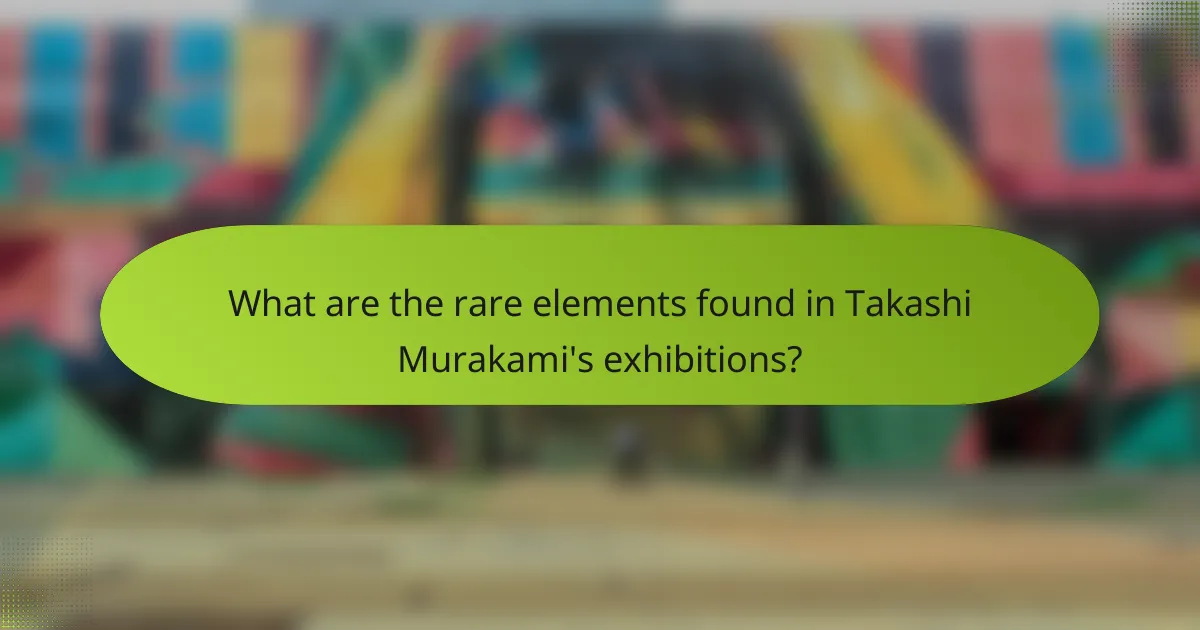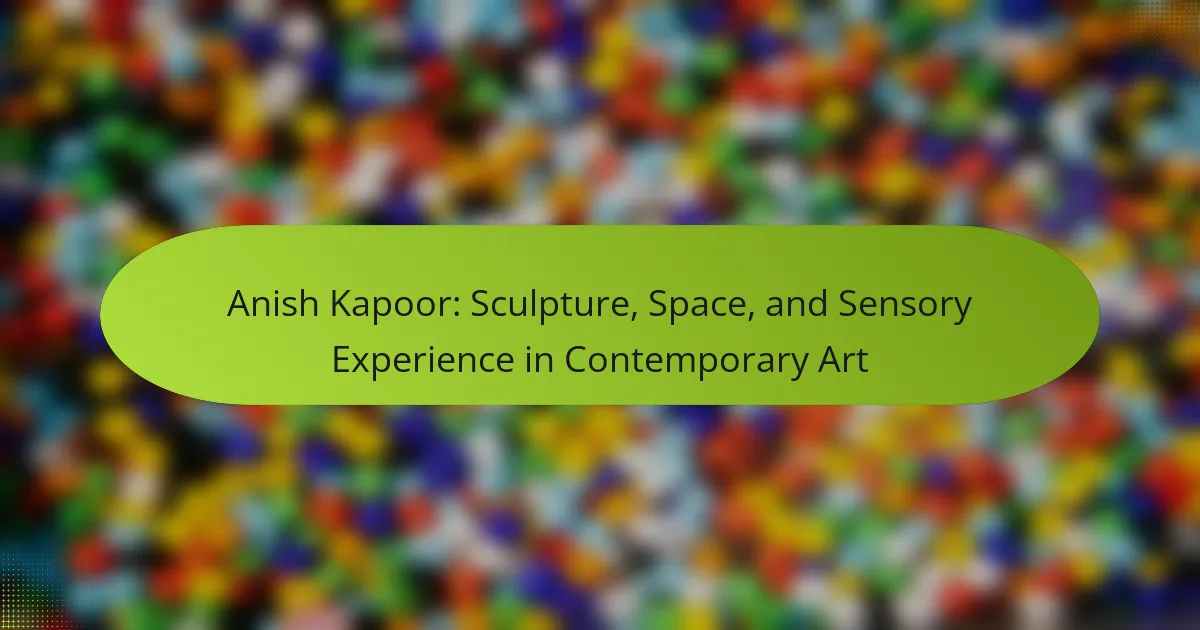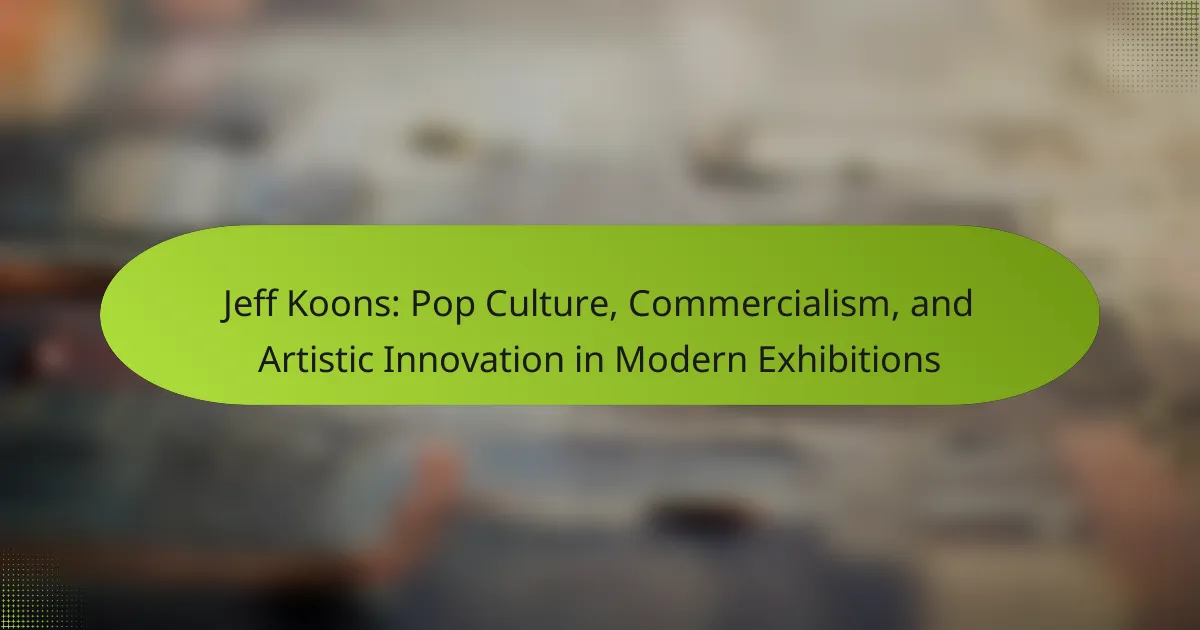Takashi Murakami’s Superflat aesthetics merge high and low culture, reflecting contemporary Japanese society. This article explores his cultural fusion, market influence, and the commercialization of art. It examines how his unique visual language appeals globally, alongside his strategic collaborations with brands like Louis Vuitton. Additionally, it highlights the innovative elements in his exhibitions that set him apart in the art world.

How does Takashi Murakami define Superflat aesthetics?
Takashi Murakami defines Superflat aesthetics as a fusion of high and low culture, characterized by flatness in visual representation and a rejection of traditional depth. This style reflects contemporary Japanese culture, influenced by anime and consumerism. Superflat emphasizes vibrant colors, simplistic forms, and a critique of post-war Japanese society, merging fine art with commercial art. Murakami’s work illustrates a unique attribute of blending cultural elements, making it accessible and marketable globally.
What are the key characteristics of Superflat art?
Superflat art is characterized by its flatness, vibrant colors, and blending of high and low culture. Takashi Murakami’s work exemplifies this through its use of commercial elements and traditional Japanese aesthetics. The unique attribute of Superflat art is its critique of consumerism, while its root attribute is the emphasis on two-dimensionality. This style often incorporates anime and manga influences, creating a cultural fusion that appeals to both art and pop culture audiences.
How does Superflat challenge traditional art forms?
Superflat challenges traditional art forms by merging high and low culture, creating a new aesthetic that emphasizes consumerism. Takashi Murakami’s work blurs boundaries between fine art and commercial design, promoting cultural fusion. This approach democratizes art, making it accessible and relevant to contemporary society. The unique attribute of Superflat is its playful yet critical commentary on postmodern life, influencing both the art market and popular culture. As a result, it reshapes perceptions of artistic value and authenticity.

What cultural influences shape Takashi Murakami’s work?
Takashi Murakami’s work is shaped by Japanese pop culture, traditional art, and contemporary commercialism. His Superflat aesthetics blend these influences, creating a unique visual language. The fusion of high and low culture reflects Japan’s post-war consumerism. Additionally, global art market dynamics further impact his artistic direction.
Which elements of Japanese culture are prevalent in his art?
Takashi Murakami’s art prominently features elements of Japanese culture, including traditional motifs, anime aesthetics, and the concept of “kawaii.” His work fuses these aspects with contemporary themes, creating a unique visual language. The use of vibrant colors and flat surfaces reflects the Superflat movement, which critiques consumerism and art hierarchies. Murakami’s incorporation of folk art and historical references further emphasizes Japan’s cultural heritage.
How does Murakami integrate Western influences into his creations?
Takashi Murakami integrates Western influences through a blend of pop culture, art movements, and commercial techniques. His Superflat aesthetics merge traditional Japanese art with Western concepts, creating a unique visual language. For example, he draws from American pop art and anime, reflecting a cultural fusion that resonates globally. This approach not only enriches his works but also enhances their market appeal, bridging Eastern and Western art traditions.

What role does commercialization play in Murakami’s art?
Commercialization significantly influences Takashi Murakami’s art by merging traditional Japanese aesthetics with contemporary market dynamics. His Superflat style embodies this fusion, appealing to both art collectors and commercial audiences. Murakami’s collaborations with brands like Louis Vuitton illustrate how commercialization enhances visibility and cultural relevance. This approach not only democratizes art but also challenges the boundaries between high and low culture, making his work accessible to a broader audience.
How has Murakami navigated the art market?
Takashi Murakami has adeptly navigated the art market by blending traditional Japanese aesthetics with contemporary pop culture. His Superflat movement challenges the boundaries of fine art and commercialism. Murakami’s collaborations with luxury brands, such as Louis Vuitton, have elevated his market influence, making him a prominent figure in both art and fashion. His unique approach to cultural fusion and marketing strategies has redefined how art interacts with consumer culture.
What are the implications of his collaborations with brands?
Takashi Murakami’s collaborations with brands enhance his cultural influence and expand market reach. These partnerships blend art with consumer culture, elevating brand identities through his unique superflat aesthetics. For instance, Murakami’s work with Louis Vuitton introduced vibrant art into luxury fashion, attracting a diverse audience. Collaborations often result in limited-edition products, creating exclusivity and driving demand. As a result, Murakami’s brand associations reinforce his status as a cultural icon while transforming traditional market dynamics.

How does Takashi Murakami’s work resonate with global audiences?
Takashi Murakami’s work resonates globally due to its unique blend of Superflat aesthetics and cultural fusion. His art combines traditional Japanese motifs with contemporary pop culture, appealing to diverse audiences. The vibrant colors and playful imagery attract viewers, while the underlying themes of consumerism and globalization provoke thought. As a result, Murakami’s influence extends beyond art, impacting fashion and design industries worldwide. His strategic collaborations with brands like Louis Vuitton enhance market presence, making his work accessible and relevant across cultures.
What themes in his art appeal to international viewers?
Takashi Murakami’s art captivates international viewers through its vibrant colors, cultural references, and commentary on consumerism. His Superflat aesthetics blend traditional Japanese art with contemporary pop culture, making it relatable across diverse audiences. The fusion of high and low culture invites global engagement, while his market influence reflects the intersection of art and commerce. These elements resonate with viewers seeking both beauty and deeper meaning in art.
How does Murakami’s style adapt to different cultural contexts?
Takashi Murakami’s style adapts to different cultural contexts by blending traditional Japanese art with contemporary influences. His Superflat aesthetic reflects a fusion of high and low culture, appealing to diverse audiences globally. This adaptability allows him to navigate various markets while maintaining a unique artistic identity. For instance, his collaborations with Western brands demonstrate how he integrates cultural elements, making his work resonate across different demographics.

What are the unique attributes of Murakami’s artistic approach?
Takashi Murakami’s artistic approach is characterized by cultural fusion, commercial savvy, and the use of Superflat aesthetics. His unique attributes include blending traditional Japanese art with contemporary pop culture, creating a visual language that appeals globally. Another unique aspect is his ability to navigate the art market, making art accessible while maintaining high artistic standards. Murakami’s works often reflect a playful yet critical commentary on consumerism and identity in modern society.
How does Murakami’s use of color and form differentiate his work?
Murakami’s use of color and form creates a vibrant, layered aesthetic that distinguishes his work. His Superflat style blends traditional Japanese art with contemporary pop culture, using bold colors and flat forms to challenge perceptions of depth and reality. This unique approach emphasizes cultural fusion, making his art accessible and commercially viable. The rare attribute of his work lies in its ability to evoke nostalgia while simultaneously engaging with modern themes, creating a distinctive visual language that resonates globally.
In what ways does his artistic process reflect personal experiences?
Takashi Murakami’s artistic process deeply reflects his personal experiences through the integration of cultural narratives and societal critiques. His Superflat aesthetic, characterized by flatness and bold colors, mirrors his childhood in post-war Japan, reflecting a blend of traditional and contemporary influences. This fusion showcases his unique ability to convey complex themes of identity and consumerism, influenced by his upbringing and the rapid modernization of Japanese culture. His works often draw on personal memories, exploring themes of nostalgia and the impact of globalization, further emphasizing how his life experiences shape his art.

What are the rare elements found in Takashi Murakami’s exhibitions?
Takashi Murakami’s exhibitions feature rare elements such as unique artistic collaborations, unconventional materials, and limited edition pieces. These aspects highlight his innovative approach to merging traditional Japanese art with contemporary themes. Notably, his use of 3D printing technology in sculptures exemplifies a rare attribute in the art world. Additionally, exclusive merchandise and interactive installations often found in his exhibitions further distinguish his work.
Which unconventional mediums has he explored?
Takashi Murakami has explored unconventional mediums such as sculpture, animation, and fashion. His work transcends traditional boundaries, combining fine art with commercial products. Murakami’s unique approach includes collaborations with brands like Louis Vuitton, showcasing his Superflat aesthetics in wearable art. Additionally, he has ventured into digital art, utilizing technology to expand his creative expression.
What unique artistic collaborations has he pursued?
Takashi Murakami has pursued unique artistic collaborations with various brands and artists, blending high art with commercial culture. His partnership with Louis Vuitton stands out, merging luxury fashion with his signature Superflat aesthetics. Additionally, he has collaborated with musicians like Kanye West, producing album artwork that reflects cultural fusion. These collaborations amplify his market influence while showcasing his innovative approach to art.

What practical strategies can artists learn from Murakami’s success?
Artists can learn several practical strategies from Takashi Murakami’s success. First, embracing cultural fusion can create unique aesthetics that resonate globally. Murakami’s Superflat movement combines traditional Japanese art with contemporary pop culture, appealing to diverse audiences. Second, leveraging market influence through collaborations with brands can expand reach and visibility. Murakami’s partnerships with companies like Louis Vuitton demonstrate the power of cross-industry collaboration. Third, maintaining authenticity while adapting to market trends is crucial; Murakami’s work remains true to his roots while evolving. Lastly, engaging with digital platforms allows for broader audience interaction, exemplified by Murakami’s use of social media to connect with fans.
How can emerging artists leverage cultural fusion in their work?
Emerging artists can leverage cultural fusion by integrating diverse influences into their work. Takashi Murakami exemplifies this approach through his Superflat aesthetics, blending traditional Japanese art with contemporary pop culture. This fusion creates unique visual narratives that resonate globally, enhancing market appeal. By adopting similar strategies, artists can attract broader audiences and differentiate their creations in a competitive landscape. Cultural fusion not only enriches artistic expression but also fosters deeper connections with varied cultural backgrounds.
What lessons can be drawn from Murakami’s approach to branding?
Murakami’s branding approach emphasizes cultural fusion and visual storytelling. His unique attribute, the Superflat aesthetic, blends high and low culture, appealing to diverse audiences. This strategy enhances market influence by creating recognizable art that transcends traditional boundaries. The integration of commercialism with fine art demonstrates how artists can effectively engage with consumers while maintaining authenticity.



